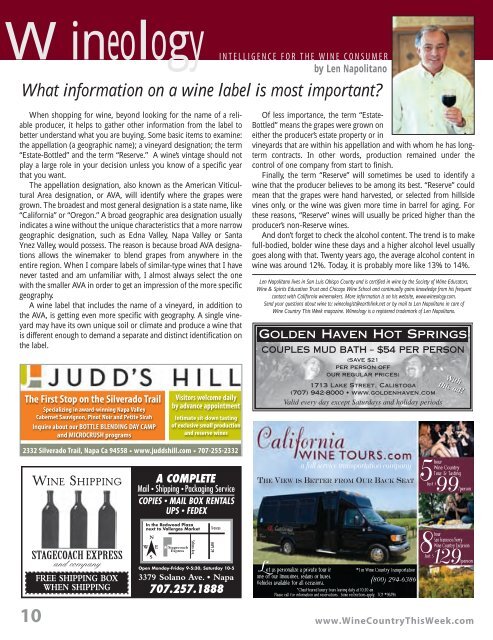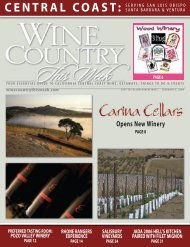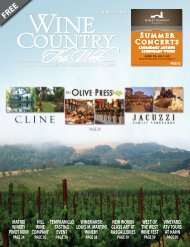You also want an ePaper? Increase the reach of your titles
YUMPU automatically turns print PDFs into web optimized ePapers that Google loves.
<strong>Wine</strong>ologyI N T E L L I G E N C E F O R T H E W I N E C O N S U M E Rby Len NapolitanoWhat information on a wine label is most important?When shopping for wine, beyond looking for the name of a reliableproducer, it helps to gather other information from the label tobetter understand what you are buying. Some basic items to examine:the appellation (a geographic name); a vineyard designation; the term“Estate-Bottled” and the term “Reserve.” A wine’s vintage should notplay a large role in your decision unless you know of a specific yearthat you want.The appellation designation, also known as the American ViticulturalArea designation, or AVA, will identify where the grapes weregrown. The broadest and most general designation is a state name, like“California” or “Oregon.” A broad geographic area designation usuallyindicates a wine without the unique characteristics that a more narrowgeographic designation, such as Edna Valley, Napa Valley or SantaYnez Valley, would possess. The reason is because broad AVA designationsallows the winemaker to blend grapes from anywhere in theentire region. When I compare labels of similar-type wines that I havenever tasted and am unfamiliar with, I almost always select the onewith the smaller AVA in order to get an impression of the more specificgeography.A wine label that includes the name of a vineyard, in addition tothe AVA, is getting even more specific with geography. A single vineyardmay have its own unique soil or climate and produce a wine thatis different enough to demand a separate and distinct identification onthe label.Of less importance, the term “Estate-Bottled” means the grapes were grown oneither the producer’s estate property or invineyards that are within his appellation and with whom he has longtermcontracts. In other words, production remained under thecontrol of one company from start to finish.Finally, the term “Reserve” will sometimes be used to identify awine that the producer believes to be among its best. “Reserve” couldmean that the grapes were hand harvested, or selected from hillsidevines only, or the wine was given more time in barrel for aging. Forthese reasons, “Reserve” wines will usually be priced higher than theproducer’s non-Reserve wines.And don’t forget to check the alcohol content. The trend is to makefull-bodied, bolder wine these days and a higher alcohol level usuallygoes along with that. Twenty years ago, the average alcohol content inwine was around 12%. Today, it is probably more like 13% to 14%.Len Napolitano lives in San Luis Obispo County and is certified in wine by the Society of <strong>Wine</strong> Educators,<strong>Wine</strong> & Spirits Education Trust and Chicago <strong>Wine</strong> School and continually gains knowledge from his frequentcontact with California winemakers. More information is on his website, www.wineology.com.Send your questions about wine to: wineologist@earthlink.net or by mail to Len Napolitano in care of<strong>Wine</strong> <strong>Country</strong> <strong>This</strong> <strong>Week</strong> magazine. <strong>Wine</strong>ology is a registered trademark of Len Napolitano.10www.<strong>Wine</strong><strong>Country</strong><strong>This</strong><strong>Week</strong>.com
















